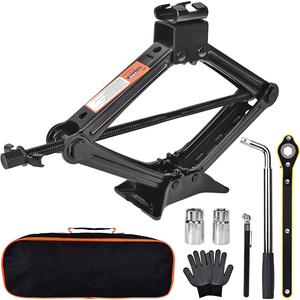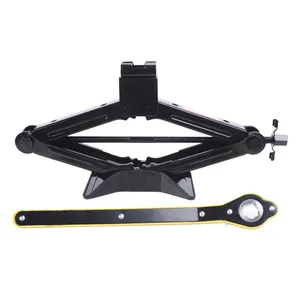Types of 1T jack
A 1-ton jack is a tool used to lift heavy loads when repairing or changing car tires. It is also called a car jack. There are several types of 1-ton jacks, each with unique features and functions to suit different lifting needs and applications. They include the following:
- 1. Trolley jack: A 1-ton trolley jack is a type of jack that has a hydraulic lifting mechanism. The hydraulic mechanism consists of a pump piston, a reservoir tank, and a release valve. When the pump handles are pushed, the piston moves, pumping the jack oil into the working chamber. This raises the load placed on the jack. The lift height of the load can be reduced by pressing the release valve, which allows the oil to flow back into the reservoir tank. The hydraulic system makes trolley jacks more powerful and easier to lift heavier loads with less effort. Besides the hydraulic lifting mechanism, a 1-ton trolley jack also has wheels that make it easy to move. It also has a rubber pad that provides a stable surface to lift the vehicle. The rubber pad also protects the vehicle from damage when lifting. The 1-ton trolley jack is ideal for lifting heavier loads, such as vehicles. It is widely used in garages for vehicle maintenance and repair. Because of its hydraulic mechanism, the trolley jack lifts loads smoothly and quickly.
- 2. Bottle jack: A 1-ton bottle jack gets its name from its resemblance to a bottle. It is a compact and cylindrical jack. The lifting mechanism in a 1-ton bottle jack is also hydraulic like that of a trolley jack. The bottle jack has two handles: a pumping handle and a release valve handle. To lift a load, users repeatedly press the pumping handle. This action causes the piston to move up, lifting the load. To lower the load, the release valve handle is turned, allowing the oil to flow back into the reservoir tank. The turning of the release valve handle and the repeated pressing of the pumping handle allow users to achieve precise load height adjustment. Besides its compact size, a 1-ton bottle jack is affordable and easy to use. Because of its small size, it can fit under a vehicle with low clearance. This makes the bottle jack suitable for low-clearance vehicles. Although a 1-ton bottle jack is portable and easy to use, it requires a lot of effort to lift a load. The hydraulic mechanism requires users to apply pressure on the handles.
- 3. Scissor jack: A 1-ton scissor jack uses a screw mechanism to lift loads. This screw mechanism has two crossed arms like a pair of scissors. When the winding handle is rotated, the arms move apart, causing the load to rise. Turning the handle in the opposite direction brings the arms together and lowers the load. The screw mechanism gives the scissor jack a simple and lightweight design. Because of this simple design, a 1-ton scissor jack is affordable. However, the screw mechanism of the scissor jack makes it slow and more difficult to lift loads. Lifting loads using a scissor jack requires a lot of effort.
Specification and maintenance of 1t jack
1t jack is available in different specifications depending on the type and model. Here are some common ones:
- Load capacity: The maximum weight that a 1-ton jack can lift is 1,000 kg or 2,200 lbs.
- Lift height: This is how high the jack can raise a load. Lift height varies depending on the type of 1-ton jack. For instance, a 1-ton bottle jack has a lift height of 20 to 60 cm, while a 1-ton floor jack has a lift height of 10 to 20 cm.
- Construction material: Most 1-ton jacks are made of steel or aluminum. Steel jacks are more durable and have a higher load capacity. On the other hand, aluminum jacks are lightweight and portable.
- Weight: The weight of the 1-ton jack varies depending on the material and design. A 1-ton bottle jack weighs between 3 to 5 kg, while a 1-ton floor jack weighs between 20 to 40 kg.
- Handle length: 1-ton jacks come with different handle lengths, making it easier to operate in tight spaces. The handle length of a 1-ton bottle jack is between 30 to 60 cm, while a 1-ton trolley jack has a handle length of 80 to 120 cm.
Here are some general maintenance tips for 1t jacks:
- Perform regular inspections: Inspect the 1-ton jack before and after every use. Look for wear and tear, cracks, damage, and leaks. Also, check the lifting mechanisms and load supports to ensure they are in good working condition.
- Clean the jack: Dirt and debris can affect the performance of a 1-ton jack. Therefore, clean it regularly, especially after using it in a dirty environment. Use a clean, dry cloth to remove dust and debris from the surface. Also, use a soft brush to remove dirt from hard-to-reach areas.
- Lubricate the jack: Lubrication keeps the 1-ton jack operating smoothly. Use the manufacturer's recommended lubricant for the different moving parts, including the handle, piston, and wheels. Remember to lubricate the jack after a specified period or after a certain number of uses.
- Store the jack properly: Proper storage prevents damage and extends the lifespan of the 1-ton jack. Store it in a cool, dry place away from direct sunlight and extreme temperatures. Keep it in a clean, dry place away from moisture and wet conditions.
- Follow the manufacturer's instructions: Always use and maintain the 1-ton jack according to the manufacturer's instructions. This ensures safe use and optimal performance. The manufacturer's manual has detailed maintenance tips and usage instructions.
How to Choose 1T Jack
-
Load Capacity:
When choosing a 1-ton jack, ensure that its lifting capacity exceeds the weight of the vehicles that will be lifted. For instance, if the business involves lifting trucks, the jack's capacity should be sufficient to handle their weight. This ensures safety and prevents damage to the jack.
-
Type of Jack:
1-ton jacks are available in different types, such as hydraulic floor jacks, bottle jacks, and scissor jacks. Each type has its advantages and is suited for specific tasks. Hydraulic jacks, for example, are popular for their high lifting capacity and speed.
-
Safety Features:
Consider the safety features of the 1-ton jack. Features like overload protection, safety locks, and stable bases are essential to prevent accidents and ensure the safety of users and the vehicles being lifted.
-
Size and Portability:
The size and portability of the 1-ton jack should be considered, especially if it will be used in tight spaces or transported frequently. Some jacks come with carrying cases, making them more convenient for on-the-go use.
-
Build Quality and Durability:
Choose a 1-ton jack made from high-quality materials that can withstand regular use. A jack with a robust and durable structure will serve longer and reduce the need for frequent replacement, thereby saving costs in the long run.
-
Ease of Use:
Consider how easy it will be to operate the 1-ton jack. Jacks with simple lifting and lowering mechanisms and clear operating instructions are more convenient for users. Additionally, features like adjustable lifting height and swivel wheels can enhance flexibility and suitability for various tasks.
-
Price:
When choosing a 1-ton jack, consider the budget, but do not compromise on quality and safety. There are various options available, so select a jack that meets the requirements without exceeding the budget.
How to DIY and Replace 1t Jack
Replacing a 1-ton hydraulic jack can be a straightforward process if you have the right tools and knowledge. Here are the steps to take:
- Read the User Manual
- Gather Necessary Tools
- Prepare the Vehicle
- Remove the Old Jack
- Install the New Jack
- Test the New Jack
1t jack replacement is easier than replacing any other hydraulic jack. Here is how to replace a 1t hydraulic jack:
- Read the user manual for instructions on replacing the jack.
- Get the necessary tools like a wrench and pliers to get the job done.
- Ensure the vehicle is on a level ground and stable before starting the replacement.
- Follow the manufacturer's instructions to remove the old jack.
- Follow the manufacturer's instructions to install the new jack.
- Once the new jack is installed, test it to make sure it is working properly.
With these steps, replacing a 1t jack should be a walk in the park.
Q and A
Q1: How heavy is a 1-ton jack?
A1: A 1-ton jack is not heavy. The weight of the 1-ton jack varies depending on the material used to construct it. Generally, a 1-ton hydraulic jack weighs between 15 to 20 pounds (7 to 9 kg). The 1-ton bottle jack tends to be heavier because it is made of steel and resembles a bottle.
Q2: Can a 1-ton jack lift a truck?
A2: Yes, a 1-ton jack can lift a truck. In the context of truck weight, a 1-ton truck refers to a truck that weighs up to 2,000 pounds (1,000 kg). Since jacks are rated based on the weight they can lift, a 1-ton jack can lift a 1-ton truck. However, users should be aware that using a jack to lift a truck requires safety measures.
Q3: How tall is a 1-ton jack?
A3: There is no specific height for a 1-ton jack. The height of a 1-ton jack differs depending on the model and the manufacturer. Generally, a 1-ton jack has a minimum height of 4 inches (10 cm) and a maximum height of 20 inches (51 cm).
Q4: How long does a 1-ton jack take to lift a load?
A4: A 1-ton jack does not lift a load instantly. It can take between 10 seconds to a minute to lift a load completely, depending on the model and the maintenance condition of the jack.






























































































































































































